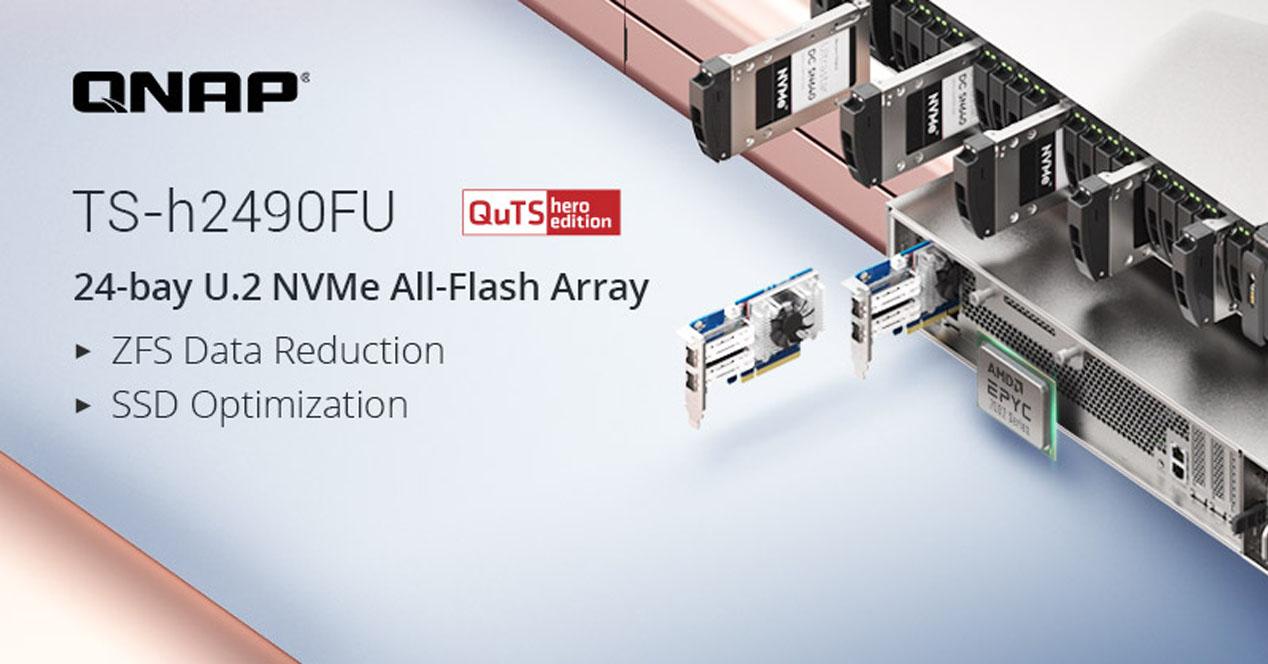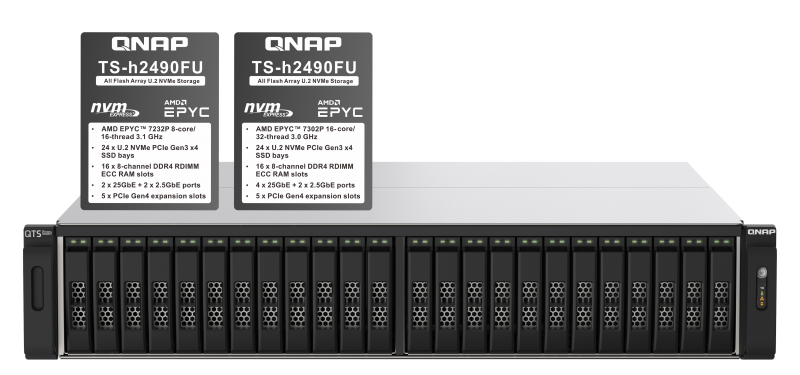
[ad_1]
Key features of this all-flash NVMe NAS
The ZFS file system provides us with great data integrity and unique features such as copy on write, native deduplication, compression and even native snapshots, making it ideal for servers where integrity is the most important. The disadvantage of this file system is that it uses a lot of RAM and therefore requires a large amount of RAM to run at excellent performance. We must also keep in mind that it is highly recommended in ZFS that the RAM be of the ECC type (with error correction), so that the data integrity is not compromised.
Processor and RAM
QNAP has released two different versions of this NAS server, the main differences of which lie in the processor, RAM and also connectivity.
The TS-h2490FU-7232P-64G model features an AMD EPYC 7232P processor with 8 cores and 16 threads at 3.1 GHz, and reaches up to 3.2 GHz when more power is required. Of course, this high-performance processor features AES-NI to accelerate hardware encryption / decryption. Together with this very powerful CPU, we have a total of 64 GB of DDR4 ECC RDIMM memory (8 modules of 8 GB), thanks to this RAM capacity we can take full advantage of the ZFS file system.

The TS-h2490FU-7302P-128G model is equipped with an AMD EPYC 7302P processor with 16 cores and 32 threads at 3.0 GHz, although it reaches 3.3 GHz, it incorporates AES-NI and we have a total of 128 GB of DDR4 RDIMM memory ECC (8 x 16GB modules).
In both server models, we can expand the RAM memory up to 4 TB (configuration of 8 x 256 GB per module). We must keep in mind that this NAS is server oriented.
storage
The storage of this NAS server is all flash, we have a total of 24 bays to accommodate U.2 NVMe Gen 3 x4 solid state drives, so we will have the best possible performance due to the fact that we can configure different storage sets in Mirror, RAIDZ-1, RAIDZ-2 and others. According to QNAP tests, we can have up to 472,000 / 205,000 random read / write IOPS
Connectivity
The connectivity of this server must be up to par with its hardware, in this case, we have a total of 2 2.5GbE ports with Link Aggregation support and we also have a total of two 25GbE SFP28 ports for the TS-h2490FU- 7232P version and a total of four 25GbE SFP28 ports for TS-h2490FU-7302P version. As if that were not enough, we also have a total of five PCie 4.0 slots (with a minimum of x4, a maximum of x8 and a maximum of x16) to increase the connectivity of this NAS by using the QM2 cards from manufacturer QNAP and also by installing a GPU . We must keep in mind that SFP28 ports allow Link Aggregation, so we can have a link up to 100Gbps of bandwidth at most.

Finally, this team also has a total of 2 USB 3.2 Gen 1 5Gbps ports and a redundant 1,100W power supply, as we are dealing with a team of professionals whose goal is to provide the best data integrity.
As for the QuTS Hero operating system, we have the same administration, configuration, monitoring and application archive options as always, but incorporating the ZFS file system.
You can visit the official website of QNAP TS-h2490FU where you will find all the details of this rackable NAS server. We recommend that you visit ours QNAP TS-1277 review, one of the best desktop-type NAS you can buy with an AMD Ryzen 7 processor, you can also read the QNAP TS-253D analysis, the best NAS for home and SME environments.
Source link